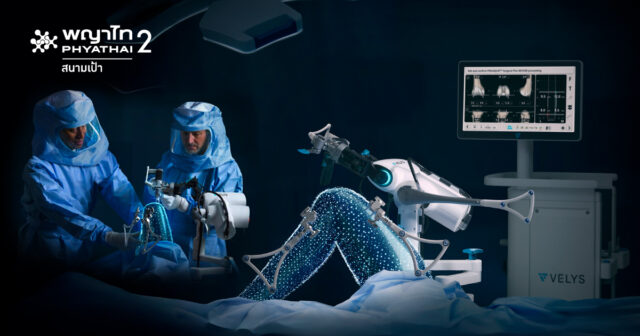How Is Robotic Assisted Knee Replacement Better Than Traditional Surgery

When knee osteoarthritis starts to interfere with daily activities—such as walking, climbing stairs, or getting up from a chair—total knee replacement surgery may be a crucial solution.
Today, the Bone and Joint Institute at Phyathai 2 Hospital introduces a new era of advanced treatment with the VELYS™ Robotic-Assisted Solution (Generation 4)—an intelligent robotic system designed to assist in knee replacement surgery.
This cutting-edge technology offers key advantages over traditional methods:
1.Greater precision in implant positioning and alignment
2.Faster recovery with less soft tissue disruption
3.Improved safety through real-time data and personalized surgical planning
Let Phyathai 2 Hospital help you move forward—confidently and pain-free—with the future of knee surgery.
Introducing VELYS™ Robotic-Assisted Solution
The VELYS™ Robotic-Assisted Solution is the latest innovation adopted by Phyathai 2 Hospital for total knee replacement surgery. The Generation 4 system offers several advanced features that enhance both surgical accuracy and patient experience:
1.No need for a CT scan, simplifying the preparation process
2.Real-time surgical planning, customized to each patient’s unique knee anatomy
3.Infrared cameras and precision sensors for highly accurate implant positioning
This cutting-edge robotic technology helps ensure better outcomes, faster recovery, and greater confidence for both patients and surgeons.
Does VELYS™ Perform Surgery Instead of the Surgeon?
No—it doesn’t! The robot does not replace the surgeon. The Robotic-Assisted Solution acts as a high-precision tool that enhances the surgeon’s control using real-time data. The surgeon remains fully responsible for planning and guiding every step of the procedure.
Does VELYS™ Require a CT Scan?
No CT scan is needed. This technology eliminates the need for preoperative CT imaging, reducing radiation exposure, preparation time, and overall costs. Instead, the system captures a 3D model of the knee during surgery, allowing real-time planning and adjustments on the spot.
How Does the Robotic-Assisted Solution Improve Accuracy?
VELYS™ uses infrared cameras and tracking sensors to help the surgeon place the knee implant with extreme precision—down to 0.5 millimeters. This level of accuracy minimizes implant wear and allows for more natural, smooth joint movement, closely resembling the original knee function.
Faster Recovery for Patients
Most patients are able to stand and walk within 6–24 hours after surgery and return to daily activities much faster compared to traditional knee replacement surgery. This is due to the high precision of the robotic-assisted procedure, which minimizes trauma to surrounding tissues and reduces the long-term risk of implant loosening.
Who Is VELYS™ Suitable For?
The Robotic-Assisted Solution is ideal for patients with moderate to severe knee osteoarthritis, especially older adults who require high precision, safety, and faster recovery. It is also suitable for individuals with complex knee structures or those who have undergone previous knee surgeries. Additionally, it is a good option for patients seeking a minimally invasive surgical experience with quicker recovery.
How Safe Is It? Are There Any Risks?
Robotic-assisted knee surgery offers a high level of safety, as it reduces human error and provides surgeons with real-time, detailed visualization of the knee structure. However, the overall safety also depends on the expertise of the surgical team and the quality of the hospital.
Why Choose Robotic-Assisted Knee Surgery at Phyathai 2 Hospital?
1.Highly experienced knee specialists who are expertly trained in robotic-assisted surgery
2.State-of-the-art Hybrid Operating Rooms, equipped with advanced technology at every stage of the procedure
3.Comprehensive post-operative care, including physical therapy, pain management, and continuous follow-up
4.Faster recovery and earlier mobility—most patients can stand and walk within 6–24 hours after surgery
5.Trusted safety standards, with real-time surgical control performed exclusively by the orthopedic surgeon
Because Your Knees Deserve More Than Just Precision
In an era of rapid medical advancement, knee replacement surgery no longer has to be painful or involve lengthy recovery. At Phyathai 2 Hospital, we bring you the VELYS™ Robotic-Assisted Solution (Generation 4)—a cutting-edge approach that delivers precision, safety, and faster recovery, all under the expert care of our highly experienced knee specialists and with the support of state-of-the-art technology at every step.
But it’s not just about advanced technology—we are committed to the principles of Value-Based Healthcare, ensuring every patient receives treatment that is truly worthwhile in terms of quality, safety, and personalized care.
Because we understand that every patient has the same goal: to return to life with confidence and quality.
Choose the right technology, a trusted medical team, and care that’s tailored just for you.


